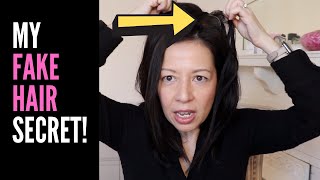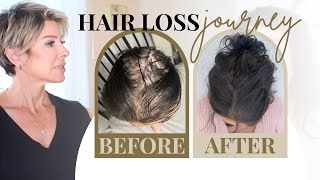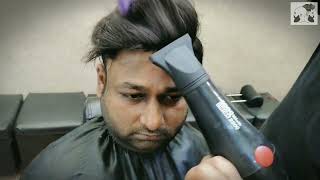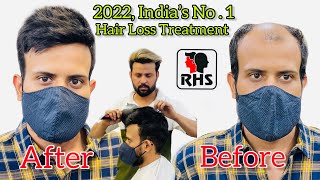5 Ways to Prepare for Hair Loss from Chemotherapy
- Posted on 02 November, 2021
- Hair Knowledge
- By Emma & Stuart

Hair loss is one of the most common and visible side effects of chemotherapy, and for many women, this can also feel the most emotionally damaging.
We completely understand the physical and emotional challenges of coping with chemotherapy treatment and to make the transition a little easier, we have prepared five top tips on the best ways to prepare for chemo hair loss as well as some options for and alternatives to chemotherapy hair loss wigs.
Choosing and Wearing a Wig After Experiencing Hair Loss from Chemo
For many people, the thought of hair loss after chemo can be harder to process than a cancer diagnosis. This is often the case because it makes your illness become visible, and something that can’t be hidden anymore, which can turn your focus purely on cancer and be debilitating and overwhelming.
It’s important to remember that your hair will grow back, but maybe not in the same way as it grew before treatment straight away. Wearing a wig could bring back some of your confidence while your hair continues to grow, which is usually around six months after chemotherapy ends. Choosing to wear a wig is a very personal decision, but with the range of chemotherapy hair loss wigs, hats and scarves available, you can choose the right option for you.
Steps to Take to Prepare for Hair Loss
1. Invest in a Wig
Many women choose to wear a wig throughout their chemotherapy treatment and often find it’s a great way to regain confidence and make them feel like ‘themselves’ again. It’s also the perfect chance to experiment with different colours and styles, providing a welcome distraction during a difficult time.
Try buying at least one wig before you start treatment; it’ll be one less thing to think about, and will help you to choose a wig that matches your hair colour and cut if you prefer a subtle transition from your natural look. You could also consider buying two wigs so one can be worn whilst the other is being washed or styled, or if you want to change up your look completely!
There are hundreds of different styles and colours of wigs to choose from; check out our gorgeous range of wigs to help you find your perfect style. We have also lovingly handpicked a collection of chemotherapy hair loss wigs that are specially designed for those undergoing treatment.
Choosing your wig
There are many different types of wigs and wig caps to choose from. Monofilament and hand-tied wigs are some of the most comfortable wigs for chemotherapy patients that we have found over the years. In particular, these wigs are super comfortable and gentle on the scalp, as the cap construction is more breathable and so less irritating on the scalp. They are also lightweight, keeping you cool and comfortable throughout the day. Hence why they are some of our best chemotherapy hair loss wigs!
Synthetic wigs have, over the years, emulated human hair wigs in look and feel. Synthetic wigs are super versatile and low maintenance, with endless colour options available. The main advantage of choosing a synthetic wig as one of your chemotherapy hair loss wigs is their affordability. Especially with the improvement in synthetic hair wigs, you won’t compromise quality for price!
Human hair wigs offer a more natural look and feel, over synthetic wigs. You can style a human hair wig similar to how you would your own hair, including using heat styling or colouring. However, they are prone to the weather and can be high maintenance, requiring frequent washing and restyling.
Top Tip 1
If you have little to no hair, we suggest using a wig cap, no matter which wig option you decide to go for. A wig cap just makes the wig fitting process a lot easier, keeps the wig more secure.
Top Tip 2
Take a sample of your own hair and a few photos of your hairstyle before you start treatment. This way you’ll be able to select a wig that closely matches your colour and cut.
2. Recreate Natural Eyelashes and Eyebrows
Hair loss during chemotherapy can also affect other areas of the body, including eyelashes, eyebrows and armpits. Before treatment, many women research how they can recreate their existing look with the help of some expert makeup tips, false eyelashes and even stick-on eyebrows. Some women consult with a cosmetologist (beautician) to learn how to pencil in eyebrows and apply false eyelashes.
We also have several tutorial videos on our YouTube channel to show you how to draw on eyebrows or how to use stick-on eyebrows to help you find a look that makes you feel like you.
3. Protect Your Scalp
Whether you opt for a new wig or choose to embrace your beautiful bald scalp, protecting your head is really important during chemotherapy treatment.
Many women often wonder how quickly hair falls out with chemo, and although there is no accurate answer, a general guideline is around two to four weeks after you have started treatment. There are many different stages of hair loss during chemo; it may fall out very quickly in large clumps or gradually and some women often experience a tender scalp during this time, so it’s important to look after it.
Some women find headscarves or other types of headwear for hair loss easier to wear during this time as they provide full head coverage and the soft material makes them really comfortable to
 ANOKI
ANOKI4. Act first: Go Bald or Short, Ahead of Treatment
At a time where many women will feel they’ve lost control of their bodies, some women prepare for chemo hair loss and find empowerment in taking action first. This could be shaving your head or cutting your hair short before the chemo has the opportunity to let your hair fall out naturally. For many, this can make it easier to adjust to a new look and make hair loss less traumatic.
If you don’t want to shave your head completely, try opting for a shorter hairstyle; this will help your remaining hair to appear thicker and fuller and can make the transition from real hair to wig much easier.
5. Pamper your Hair and Scalp
Before you start treatment, it’s important to show some love to your hair and scalp. Avoid bleaching, colouring or using heat such as straightening or curling irons as this weakens hair. Try air-drying as much as possible, and avoid hairstyles which tug such as ponytails or plaits. This will help keep your hair as strong as possible before you start treatment.
During your treatment, as your skin and scalp will become more sensitive, avoid using shampoos and lotions which contain strong fragrances, alcohol or salicylic acid. Use a soft-bristle hairbrush, gentle shampoo (only washing your hair when necessary) and moisturising skin lotion.
Top Tip 3
After you finish treatment, your new hair will be very fragile and vulnerable to damage, so continue to avoid using heated styling devices. For more information, our recent blog post on how to style your hair during regrowth gives you some more inspiration on shorter hairstyles.
Preparing for chemotherapy is a very personal journey and it’s important that you find the right tips and tricks that work for you. We want you to feel supported and comfortable during your hair loss journey and there are many ways to regain self-confidence after chemotherapy to help you do this, whether with chemotherapy hair loss wigs or other alternatives.
Read our blog for more advice and support or contact our friendly and helpful team who will be more than happy to answer any questions you may have about coping with hair loss and finding the right solution for you.




